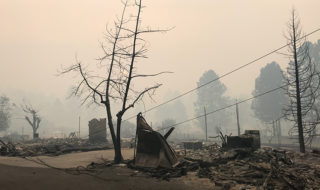Fuel surplus could cause another destructive wildfire season
Berkeley professor of fire science Scott Stephens says 2019's heavy rains have left grasslands more susceptible to large wildfires
July 11, 2019

Fire crews work on a wildfire in California. The 2019 fire season could be as destructive as earlier fire seasons. (U.S. Forest Service photo by Mike McMillan under Creative Commons 2.0)
Eight months after the Camp Fire consumed the Northern California town of Paradise and was pronounced the deadliest wildfire in state history, California is facing the potential in the coming months for more death and destruction.
Scott Stephens, a UC Berkeley professor of fire science, says the heavy rains of February and March have left California grasslands with perhaps twice as much burnable fuel as this time a year ago.
“Most of the time, you’d have one ton of dry mass per acre, and right now it’s about double that,” Stephens, who has spent a quarter century in Berkeley working on fire behavior, fire ecology and forest policy, says. “I would expect grassland fires to be more intense and move around more quickly because of that.
“All that dry grassland will be responsive to sparks and flying burning embers. The fuel load will increase flame lengths. Once the grasslands start to burn, they could produce more embers themselves, since they have higher fuel loads.”
Stephens says California could help itself greatly by following the Australian model of fire prevention, where there is regular governmental outreach to people who live in fire-prone areas.
That’s one reason he’s a keen booster for Senate Bill 462, which is currently under consideration in Sacramento. One segment of the bill calls for the development of a group of outreach advisors who could be in the field long before a firestorm, giving advice about fire issues to those most likely to need it.

Data from the weather satellite GOES shows the Camp Fire as it spread from ignition and through the town of Paradise on Nov. 8, 2018. Such images, downloaded quickly, could be used to alert fire, police and residents of developing wildland fires. (Image courtesy of Jeff Chambers)
“This is not an average year,” he says. “The grasslands in some places are twice as tall as normal. That makes fire prevention more challenging, particularly at the urban wildland interface,” where homes are built on or adjacent to fire-prone lands.
“In general,” he adds, “the state has not done well to engage people and acquaint them with their vulnerabilities.”
“The UC Extension programs across the state have been doing this kind of thing in agriculture for 50 years,” Stephens says. “These are people who live in the counties most impacted and who can make a difference. We should be taking some inspiration from Australia and do the outreach about fire within communities and city councils.”

The Camp Fire at 10:45 a.m. on Thursday, Nov. 8, 2018, four hours after it broke out, likely at the easternmost edge of the burn (right). (Landsat data analysis and overlay courtesy of Jeff Chambers)
Stephens has spoken several times in Sacramento on behalf of SB 462, calling it “a critical program for the state to move forward.” The Camp Fire, and the Carr and the Tubbs fires that preceded it, may have gotten California out of a legislative quagmire concerning fire, although it’s an open question whether or not the legislature will ever get a bill to Gov. Gavin Newsom’s desk.
“In my two years doing this, I’ve never seen the state do what has been done the last two years,” Stephens says. “Both the legislature and the governor are moving into fire areas, trying to understand things better. This bill came out of the education committee in the Senate and got the support of a lot of environmental committees.”
As originally written, the bill’s funding would have been $20 million. Once the bill arrived in the appropriations committee, however, that figure was reduced to $1 million, and the bill currently is awaiting consideration by the Assembly Natural Resources Committee.

Last November’s Camp Fire left almost nothing behind in the Northern California town of Paradise. (Photo by Ashley Estep-Earley under Creative Commons)
Stephens says the funding cut would mean only two or three people could be hired to do the kind of outreach he envisions across the state. The original funding would have seen the hiring of perhaps 15.
Wildfire season in California has typically run from mid-summer through late autumn, although the last two seasons have stretched that. Stephens says getting ahead of the wildfire season would include, in addition to outreach, the passage of Senate Bill 462 and a concerted effort to mow or trim the dried grasslands.
“We need to see what is happening,” Stephens says. “Right now, the people who are dying in these fires are the elderly, the vast majority of whom are over 65. These are people who are not as mobile and who don’t have the same resources. They are the ones who need this outreach.”